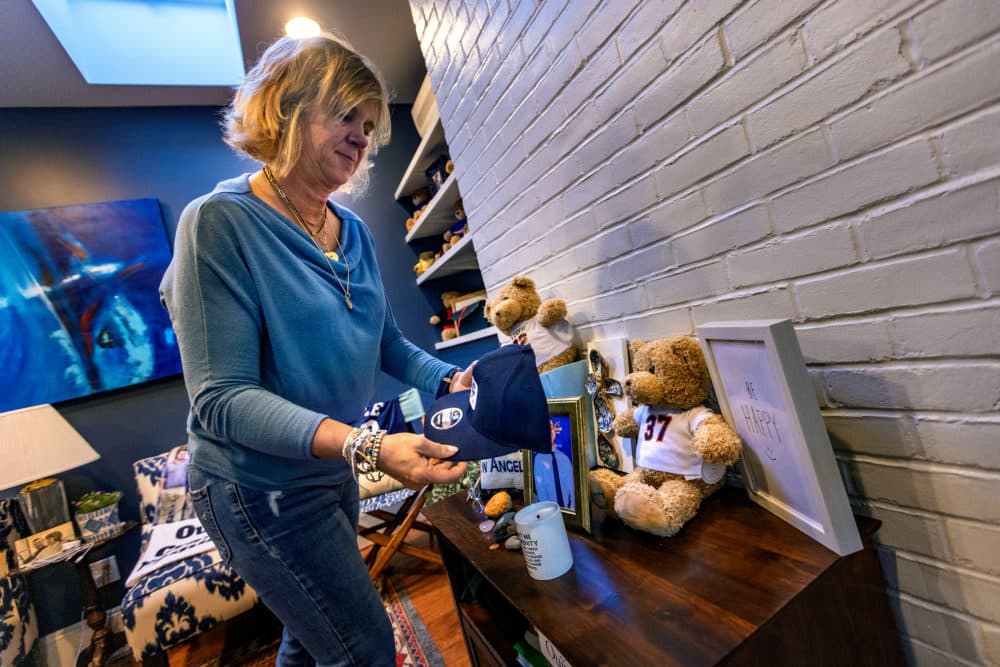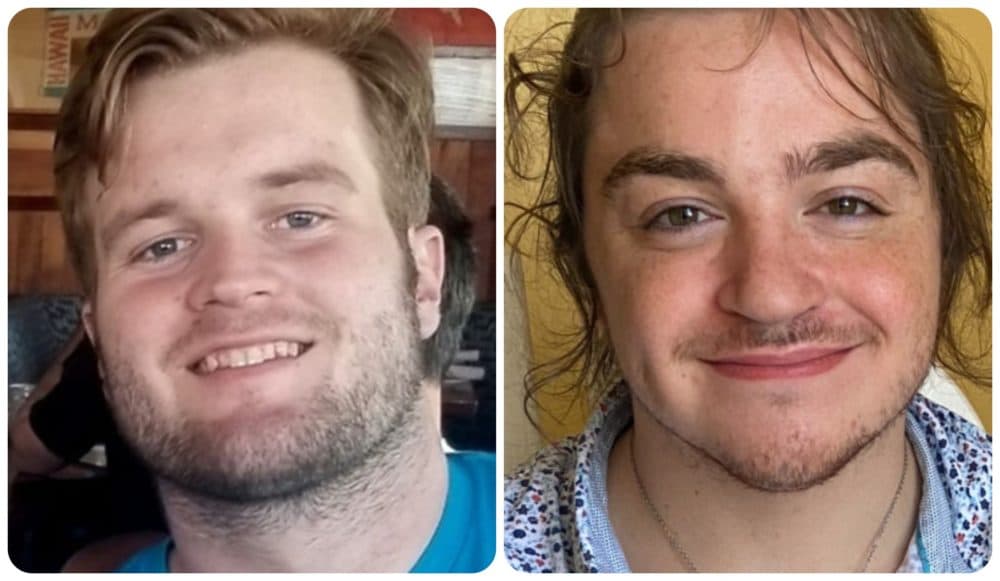Advertisement
Tackling the fake pill supply killing teens and young adults
Resume
On the evening of May 1, Sam Cioffi headed out to celebrate. He’d just set a Salem State University men’s record for the most lacrosse goals scored in one season. The next morning, Sam was dead. His mother, Sally Cioffi, pieced together details to figure out what happened.
Cioffi says Sam, 22, went to a bar. She didn't want him to drive after drinking, so Sam took an Uber back to his friends' house. Along the way, Cioffi says Sam took what he thought was a Percocet, a prescription painkiller. It wasn’t.
The toxicology report showed Sam swallowed fentanyl, an opioid 50 to 100 times more powerful than the ingredients in a Percocet. Cioffi traced this deadly fake pill purchase and some other recreational drug purchases using Sam’s phone. Cioffi read the Instagram and Snapchat messages Sam exchanged with a dealer.
“That’s how these kids find the drug dealers is on Snapchat and Instagram.”
Sally Cioffi
“He kind of like, friended him,” Cioffi said of the dealer. “That’s how these kids find the drug dealers is on Snapchat and Instagram.”
Cioffi says Sam and many other young people don’t realize the risk they are taking with just a few swipes on an app.
“These kids think they’re invincible,” Cioffi said, her voice cracking, “and they’re not. They need to know it’s dangerous.”

In online support groups, parents post similar stories every day — of lost teens and young adults who purchased a fake pill that was delivered after a few taps on their phone. Many say their children were poisoned.
Opioid related deaths have nearly doubled for 15- to 24-year-olds since 2015. For teens in particular, deaths linked to fentanyl have more than doubled since 2019.
National Institute on Drug Abuse director, Dr. Nora Volkow, says teenagers rarely use fentanyl intentionally. What they do consume are ADHD medications, opioids for pain relief and sedatives to help with sleep or relieve anxiety.
“That’s where these illicit pills come into the fore,” said Volkow, “because they are being disguised as these drugs, but they are basically fentanyl.”
And they are not hard to find.
'An insidious move'
“Social media has become a superhighway of drugs,” said Jon DeLena, deputy special agent in charge of the federal Drug Enforcement Administration’s New England field division. “If you have a smartphone and a social media account, a drug trafficker can find you.”
Four of every 10 pills the DEA tests contain a lethal dose of fentanyl. Fake Percocets are common, but DeLena says investigators also seize pills that look like Xanax, codeine and Adderall. He says drug cartels are making a broad range of fake pills to try to reach a wider market.
DeLena says most fake Adderall pills have typically contained the illegal stimulant methamphetamine. But recently, during a shortage of one type of Adderall, the DEA is seeing an influx of fentanyl made to look like Adderall. DeLena says most of these pills are produced by Mexican drug cartels.
“We know in this country who the major consumer of Adderall is,” said DeLena referring to school-age children. “That’s an insidious move on behalf of those two deadly cartels.”
DeLena says the DEA is going after the cartels, their delivery networks and money brokers.
He says social media networks need to step up warnings to users and block more sales.
“These companies in general need to do more,” DeLena said.
How social media companies are cracking down
Snap, the owner of Snapchat, and Meta, the parent company of Instagram and Facebook, say they are doing more to remove drug-related content and make it easier for parents to monitor their children's activity on their platforms.
Snap says stronger monitoring tools are helping catch 90% of drug activity, ban dealers and keep them from creating new accounts. The company says a year ago, when users reported drug-related content, 23% of it was about a drug sale. Last month, that dropped to 3.3%
Meta’s latest report shows it took action on nearly 2 million drug-related posts, photos, videos or comments on Instagram between April and June this year.
Instagram and Snapchat both launched parent supervision programs within their apps this year.
“What we need to do is get the social media companies, law enforcement, the DEA, all sitting at a table and saying all of us are in this together.”
Ed Ternan
Snapchat tries to make it harder for dealers to find teenagers by hiding users who are under 18, unless the teen and the person searching have multiple mutual friends.
“We are committed to bringing every resource to bear to keep fighting this epidemic both on our app and across the tech industry, and will be rolling out additional initiatives in the coming months,” a Snap spokesperson said in an emailed statement.

In an unusual move, Snap and Meta are sharing information about trends they notice on their platforms to improve detection of illegal drug activity. The two companies say they block hashtags such as #buyxanax, and intervene in searches for illicit drugs by name and their slang substitutes.
Drug search terms change frequently. The DEA has a sample of the words and emojis — a bus for Xanax, for example — in vogue recently. On Snapchat, Facebook and Instagram, users who seek drugs are directed to a national helpline or to a new public education campaign coordinated by the Ad Council and funded by Snapchat and Youtube.
TikTok, Reddit and Twitter have said they’ll distribute the information and warnings in the campaign as well. These sites also have policies for reporting and removing illegal content but did not provide specific details about how much drug-related content they remove.
Parents call for more action
Many parents say the steps social media companies are taking don’t go far enough.
Jaime Puerta’s 16-year-old son, Daniel Puerta-Johnson, died after taking a fake pain pill that Puerta believes the teenager purchased on Snapchat. Puerta wants warnings about fentanyl-laced pills to pop up for all users, not just those searching for drugs. He also wants broader parental access to a child’s accounts and more tools to prevent adding dealers as friends.
Puerta and a small group of parents filed suit against Snapchat in October. They argue that Snapchat’s features, including disappearing messages, encourage illegal drug sales.
Other parents are choosing to work with social media companies rather than sue. Ed Ternan, who lost his son Charlie Ternan, 22, to a fake Percocet, is on Snap’s Safety Advisory Board.
“What we need to do is get the social media companies, law enforcement, the DEA, all sitting at a table and saying all of us are in this together,” Ternan said. “This is going to get worse unless we all find ways to cooperate and stop pointing fingers and blaming.”

Here’s one way the risks are already getting worse. Toxicology reports are revealing new and more toxic opioids in some fake pills. Jill Maiorana says her son Joey Bernard, 18, died a year ago after taking what was sold as a Percocet on Reddit. In fact, it contained an opioid 10 times more powerful than fentanyl.
Some public health experts say the illicit drug supply is getting more and more dangerous, with new versions of potent opioids and other synthetic drugs.
“I have never seen the market fluctuate so much,” said Nabarun Dasgupta, an epidemiologist at the University of North Carolina, Chapel Hill who has studied drug use and tested drugs sold on the street for more than 20 years. “It’s really scary.”
Dasgupta’s research shows the content of counterfeit pills varies across the country as smaller dealers test and press new blends. Dasgupta says his work with people who use drugs shows that peer pressure is a more powerful way to influence behavior than ad campaigns. But wherever the message to young people comes from, it has to be consistent: Don’t take other people’s pills.
“They think because it’s a prescription they are safe. Nobody is safe.”
Jennifer DuBois
Jennifer DuBois agrees — that warning has to be reinforced by peers. She wants schools to get more involved.

“A lot of schools think if they talk about drugs they are putting the idea in kids’ heads, but they’re already sharing Adderall prescriptions,” she said. “They think because it’s a prescription they are safe. Nobody is safe.”
DuBois says her son Cliffton DuBois, 19, mistakenly thought he was avoiding dangerous drugs on April 21, 2021 when he took what looked like a Percocet. DuBois says both she and her son knew fentanyl was often sold instead of heroin and could be in cocaine. They didn’t know it was in pills. Many people still don’t.
A survey conducted by Ternan’s nonprofit, Song for Charlie, found just 31% of teens and young adults know about fentanyl, and only 36% know that it may be in a pill that doesn’t come from their doctor.
Few schools up to speed on fake pill threat
Warnings about “fentapills” are spreading, slowly, to middle, high school and college campuses.
In Plymouth, Massachusetts, school health leaders distribute the DEA’s One Pill Can Kill fact sheet. They train middle and high school nurses to warn students and parents about fake fentanyl-laced pills. And all schools in Plymouth stock the overdose reversal medication naloxone, in case staff need to revive someone who has stopped breathing after ingesting fentanyl.
But Carilyn Rains, the director of school health services in Plymouth, and a past president of the Massachusetts School Nurse Organization, says many of her colleagues are just learning about the fake pill problem.
We can’t “have our heads in the sand and feel like this issue doesn’t affect the school age child,” Rains said, “because it certainly can and does.”
Stocking naloxone and spreading information about potentially deadly counterfeit pills is not routine on college campuses either, said Liz Prince, who co-chairs the Alcohol, Tobacco, and Other Drugs Coalition for the American College Health Association. She said there are some innovative programs, like the naloxone kits some West Virginia colleges and universities are installing in dorms and student union buildings.
Prince cautions that one harm reduction measure may be less effective with counterfeit pills. Fentanyl test strips aren’t reliable with pills unless you crush and test all of the contents. Sampling one edge of a pill might miss the fentanyl.
Prince urges student health centers to partner with other campus or community groups in warning about the danger of taking fake pills because, she says, “This is not going away.”
This article was originally published on November 14, 2022.
